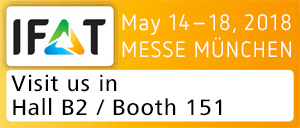You are here:
>
Trade Fair Topics Water To EnergyIFAT 2018
- WTE
- Water To Energy
Trade Fair Topics Water To Energy
Phosphate fertiliser from sewage sludge
Sewage sludge is rich in nutrients because, at the biological stage, bacteria utilise materials contained in sewage to build up biomass. In this respect nitrate, phosphate and other nutrient salts are especially significant for agriculture.
The sludge needs to be conditioned in order to extract water from it. This is done by adding lime water for example. The addition of approximately 20 to 35% calcium oxide in the solids content contributes significantly to its effectivity as a fertiliser.
Sludge that fulfils sewage sludge regulations regarding the level of pollutants as well as the requirements of fertiliser regulations regarding the level of nutrients is classed as an approved fertiliser in Germany. Sewage sludge with an official "highest quality" classification - possessing advantages for plant cultivation in the areas of nutrition, humus supply and lime effect - is known as ‘sewage fertiliser‘.
The current discussion about excessive heavy metal content in sewage sludge has led to trials being undertaken to obtain phosphate fertiliser from incinerated sewage sludge. It is planned to produce 30,000 tons of fertiliser from sewage sludge in Berlin and Hamburg in the future. The German market currently requires 3 million tons of phosphate fertiliser.
Phosphor recovery
In Germany, about 42,000 tons of phosphor accumulates in sewage sludge and waste water per year. However, phosphor should not be present in water areas as the eutrophication damages the flora and fauna.
Up to 40% of the phosphor can be recovered (approximately 15 tons of phosphor from 1,600 tons of dried sewage sludge). This is an interesting market, because there are only about 70 years worldwide reserves of phosphor, which is irreplaceable in the fertiliser market.
Utilisation of heat from waste water
In energy-optimised buildings, waste water lines continue to cause loss of warmth. The flow of warm waste water in larger communities is a source of warmth that can be utilised to produce warming and/or cooling energy.
This means that waste water is an innovative source of energy that can heat more than 10% of all buildings in Germany. With modern heat exchangers and heat pumps, warming energy extracted from waste water can be used for heating buildings or tap water.
Production of industrial carbon dioxide
In connection with the "Factory of the Future" programme, EVN is running a pilot project at the Dürnrohr power station. Here carbon dioxide is washed out of the smoke gas, resulting in a highly concentrated form of clean gas. This can be liquefied and sold as a valuable raw material.
The gas represents the starting point for many chemical syntheses. It is used for the production of methanol, plastics such as polycarbonates (e.g. for DVDs), pain killers (e.g. aspirin), content for fire extinguishers, certain laser techniques and of course for soft drinks.

